- | 6:00 am
Meet the designer who’s turning self-care into viral Instagram posts
The New Happy will help you picture the best practices of mental wellness.

Last week, something slightly bad happened to me. I spilled something. Or we ran out of milk. Or the dog stepped on my foot. It was a small inconvenience, and truthfully, I can’t even remember it now. But I do remember what happened next: Standing in my kitchen, I pictured, of all things, something I saw posted on Instagram. And I felt better.
As odd as that sounds, I’m hardly alone. Nearly 400,000 people follow the New Happy, an account founded by Stephanie Harrison—who also runs the New Happy newsletter and podcast, and is currently working on a book. In an internet filled with countless memes and endless platitudes about self-care and mental wellness, Harrison cuts through the noise with her artfully illustrated, scientifically backed visualizations about mindfulness, kindness, and the general mental framing to live a happier life
“We have all this great research, but it’s just locked in these scientific journals,” Harrison says. “If I can help break it out of there and help people . . . that was my goal in sharing on Instagram.”
In Harrison’s hands, self-help clichés are reimagined as novel data visualizations. Using a simple language of basic shapes and colors, Harrison guides you to savor the moment . . .
. . . illustrates why burnout isn’t a personal failure . . .
. . . reminds you to pursue joy . . .
. . . and subtly urges you to face your fears.
You won’t just find just one fresh visualization on her feed but dozens, each of which garners tens of thousands of likes. Not bad for someone who didn’t even start out in design.
Harrison spent a decade climbing the corporate ladder before finding her new purpose. She worked at the ad agency BBDO, the consultancy Deloitte, and, eventually, at LinkedIn, where she managed product launches.
“I’d gone through this treadmill of accomplishments and achievements I thought would lead to a state of lasting fulfillment and bliss,” Harrison says. “And of course, I never got there.”
By the time she was at LinkedIn, Harrison opted to go back to school part time, where she pursued her master’s degree in applied positive psychology. And ultimately she came to the conclusion that many others have: that the capitalist rat race teases an existential joy that never arrives.
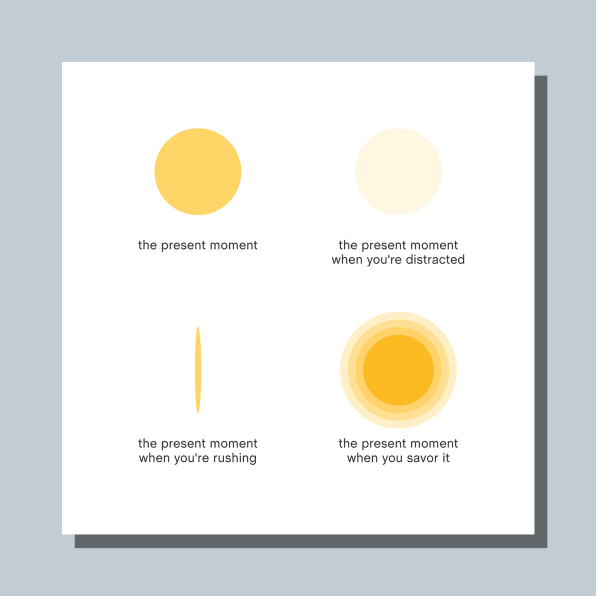
[Image: courtesy Stephanie Harrison]
“The difficult part is we think it’s leading us to happiness, and so we blame ourselves,” she says. “I started wondering, maybe the way we’re pursuing our own personal happiness might be having all of these unintended consequences. I started studying it in scientific literature and found robust findings backing it up.”After wrapping up her studies, Harrison landed a position leading digital learning at Arianna Huffington’s wellness startup, Thrive Global. While she stayed only a year, Harrison also used this time to found her own company, the New Happy. It’s a company of one, and Harrison makes her living by consulting at firms including Microsoft, LinkedIn, and Capital One to teach executives how to create cultures with an emphasis on well-being. But along the way, her Instagram account has become a mini empire of its own—and no doubt, her everyday viral posts reach as many people as any new best-selling self-help book.
“The corporate consulting is really how I pay my bills, and the rest is working more toward the long term of setting up these platforms that will hopefully [help society],” she says.
Getting to this point has been a bit of a grind. Harrison, like many, grew up appreciating art but never knowing design was a profession. As she studied psychology, Harrison began to visualize concepts for herself with small doodles. She founded the New Happy Instagram account in late 2018. Then around the beginning of the pandemic, with lots of free time on her hands, she decided to put some more of her visual thoughts out there. She gave herself an initial goal of publishing one illustration relating to mental health a day.
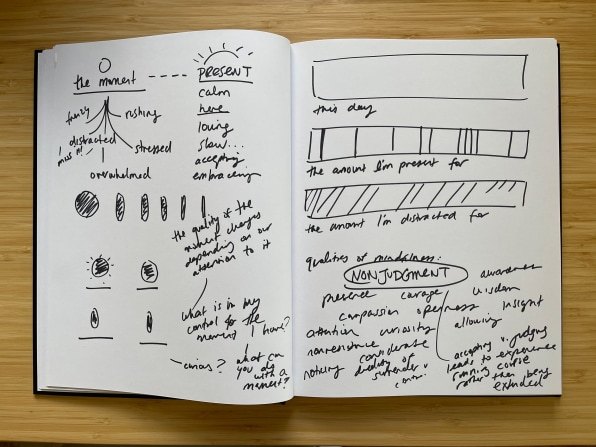
[Photo: courtesy Stephanie Harrison]
Starting with a sketchbook, Harrison will first write down an idea in words (the idea will be based upon a scientifically backed wellness principle). Then she’ll begin playing with how to illustrate that idea on paper before she brings the early concept into Adobe and Pixelator to finalize. As a self-taught graphic designer, when she started posting on Instagram her illustrations looked more like the types of social media posts generated by systems like Canva—she tried lists and posts that felt like clip art. She even made a happiness Mad Lib.
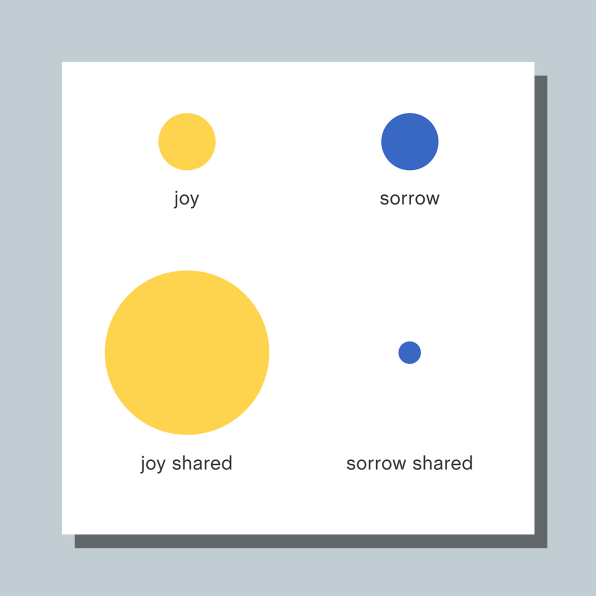
[Image: courtesy Stephanie Harrison]
The posts weren’t bad, per se, but they featured a scattershot approach that tended to talk about mental health as an idea more than articulating it as an experienced sensation. Then around a year ago, her point of view clicked.
“I try to keep it as simple as possible,” Harrison says. “What can you do with a shape? That’s what always blows my mind with masters at work. What they can do with a shape, or colors of the shape, or lines. . . . I’m always reminded there’s an infinite number of ways to [convey an idea].”
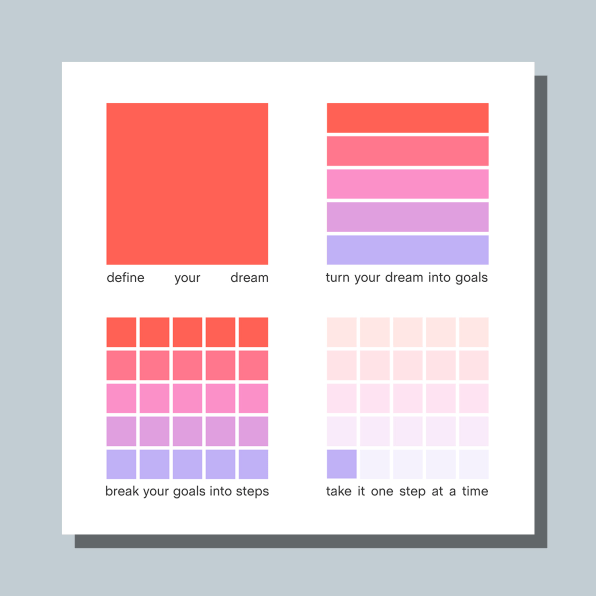
[Image: courtesy Stephanie Harrison]
Using the simple geometries of Bauhaus and midcentury-modern design, along with the sheer energy of abstract expressionism, Harrison’s feed went from visual advice to advice visualization. We might have heard the psychological concepts dozens of times before, but she cracked the code to illustrating them in a way that stamps their significance straight onto your brain.However, just because she is successful doesn’t mean the job is easy. Now posting about four times a week, Harrison readily admits that she has all sorts of ideas in her sketchbook and on her computer that she just can’t quite illustrate—yet—and so she’ll come back to them again and again, hoping inspiration strikes.
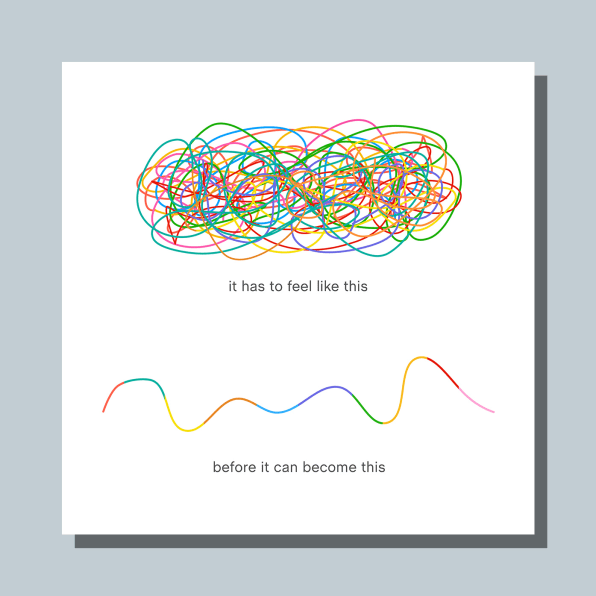
[Image: courtesy Stephanie Harrison]
“One thing I’ve been playing around with is someone you see is not all that they are,” Harrison says. “The cheesy approach is the iceberg, that you have all this beneath the surface. But what would a modernist version of that look like? How can you articulate ways we might be hiding ourselves from other people?” Those questions aren’t hypothetical; she simply hasn’t answered them yet.As for the future of Harrison’s business, she plans to keep investing her energy into her Instagram feed, her podcast, and her newsletter, but she’s not currently planning to monetize the New Happy through ads or subscriptions. “They’re for our community,” she says. “Our whole thesis is that well-being is collective, and in order to experience personal or individual well-being, we have to prioritize the collective. For my job, I view it as being the facilitator of this community and help[ing] them get what they need to be well and take that out into the world around them.”
Keeping that relationship “sacred” is Harrison’s chief priority. So for now she’ll continue to consult with companies and publish her first book, which will be a mix of writings and illustrations similar to her Instagram feed when it’s released in the winter of 2023.
“[Ideas like] living with compassion or in service to the world can sound very divorced from our day-to-day reality, but they’re not,” she says. “And figuring out how to embody them and represent them in a way is something I find helpful as well. Even if I didn’t have anyone following me, I think I’d still be making them, because they fill me with a great deal of joy.”




































